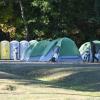Geocaching: High-tech game of hide-and-seek
There is an alternate universe out there where people use satellite coordinates to search for hidden treasures. If it sounds a little quirky, think again. To anyone who likes the outdoors and the thrill of the hunt, geocaching is addictive.
| GEOCACHING TIDBITS |
|
To learn more about geocaching and find coordinates go to geocaching.com, or look for one of numerous other websites set up by individuals and groups.
For information on the Delaware Geocache Trail go to visitdelaware.com/geo. The first GPS-located geocache took place on May 3, 2000, in Beavercreek, Ore. On 10-10-10, to commemorate 10 years of geocaching, a record of more than 78,300 finds was reported. |
Geocaching is one of those terms people hear and wonder what techie language people are speaking. But if you break the words apart – geo, or where you are – and cache, a secret spot – it makes perfect sense.
Geocaching is a worldwide game of hiding and seeking “treasure” using global positioning system (GPS) technology. Since its start 11 years ago, the treasure, known as geocaches, has been placed in more than 100 countries. More than 1.2 million people are actively involved as geocache hunters.
Erin McKinley, a state park naturalist, said geocaching is treasure hunting, hide-and-seek and a scavenger hunt all rolled into one. She and fellow naturalist Jamie Bunting instructed a small group of neophytes into the world of geocaching Saturday, Jan. 22, at Cape Henlopen State Park.
The pair said they have offered several geocaching programs in the park where at least five geocaches are hidden. Geocaches have been placed in all Delaware state parks.
And it’s not all about searching and finding. Geocachers can place a geocache anywhere in the world, pinpoint its locations with a GPS and then share the cache’s location online.
A GPS is an electronic device that can determine approximate location anywhere in the world – within 6 to 20 feet – using latitude and longitude. GPS receivers are small computers that receive signals broadcast from GPS satellites. Reading signals from at least three satellites at a time, the receiver calculates its general location using a process called triangulation, said McKinley. With signals from four satellites, a GPS device can get a more accurate fix, allowing hunters to get even closer to caches.
During park program searches, it became apparent that it’s not always easy to traverse the area the GPS device points to. Obstacles – such as thick vegetation or even rivers – are formidable deterrents making it difficult to reach a cache. It is then up to the hunter to find the best way around the obstacle and get back on the trail, Bunting said.
All about geocaching
McKinley said the containers can be just about anything from small plastic film canisters to metal ammo boxes. Most geocaches contain small trinkets, called swag, for the finders and usually a logbook. She said some contain disposable cameras for finders to record their photograph. “It’s important if you take something that you put something back,” McKinley said.
She said a diamond ring has been hidden in a geocache somewhere in the state of Washington and has yet to be found.
Bunting said rules assure that everyone can enjoy the activity. Among those rules are always replace a geocache in the exact same location where it was found, and never go on private property without permission. The geocaching.com website explains where geocaches are located and if the cache is on public or private land where landowners have allowed it.
Those who find caches often return to the website and comment on the search.
Bunting said it also pays to be as discreet as possible when searching for a geocache to keep from being “muggled,” or found out by a nongeocacher who may remove or vandalize the geocache. The term comes from the popular Harry Potter books; Muggles are ordinary human beings who are not born into the magical world.
Not all geocaches are created equal. Although coordinates are provided, some are more difficult to locate than others. Degrees of difficulty are available on geocaching websites.
Geocaches are hidden in any number of ways – in the ground, under vegetation or sticks and behind objects.
“Some offer riddles and clues to another cache and some are educational at historical sites that help us unravel the past,” McKinley said.
Within a 5-mile radius of Lewes, there are at least 100 geocaches. Some are part of the Delaware Geocache Trail, but most have been placed by individuals and businesses, like Dogfish Head in Milton. Within 25 miles of Lewes, that number grows to more than 500 geocaches.
















































